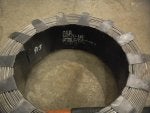@ kestrel452 - View FCAW-G as a deep fusion and heavy deposition rate welding process for multi-position work on thick materials. Yields a spray-like transfer with minimal spatter. As 'lotechman' mentioned, the process typically delivers Charpy V-Notch impact toughness tested to -40°F. Know a dude who fabricates massive bulldozers using 0.052" and 0.0625" outer shield wire. The welds are pro. Personally, have only run FCAW-G on 1/4" mild steel in 2F & 3F positions. Reminds me of a hot version of SMAW with easy:easy slag removal. FCAW-S is a cheap alternative to solid MIG and, as others have stated, gives deep fusion. Spattery, but good fusion.
From Lincoln Electric,
"Gas-shielded, flux-cored electrodes incorporate a double shielding system by using an external shielding gas as well as a slag system. The shielding gas is required to protect the arc and molten metal from the atmosphere. It also results in exceptionally smooth arc characteristics, compared to self-shielded electrodes. They use either a rutile slag system or a basic slag system. The rutile system is the most common and is characterized by a smooth arc with complete slag coverage of the weld. The basic slag system, while producing a globular metal transfer and thinner slag coverage, can be more resistant to weld cold cracking.
Most FCAW-G electrodes are ideal for all-position welding and all deliver great mechanical properties with high deposition rates. They are used effectively in general shop fabrication, structural steel (including seismic applications), shipbuilding, offshore, pipeline and other applications. FCAW electrodes can be used similarly to SMAW electrodes with a few notable benefits in the process itself. First, SMAW electrodes must be fed manually into a weld joint, making only short welds and resulting in a lot of stop and restart areas in the weld. Restart areas generally have a higher chance of containing a weld defect than any other part of the weld. With the FCAW process, the weld can be made for as long as the welder can comfortably reach before having to stop the arc and reposition themselves. This results in less restart areas in the weld, and ultimately, less chances for weld defects."










